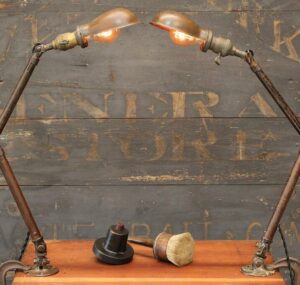Industrial design is a fascinating field that seeks to harmonize the fundamental tenets of aesthetics, efficiency, and practicality, resulting in powerful lighting solutions that effortlessly illuminate our lives. At the heart of this discipline lies industrial lamp design, which combines these principles to create iconic fixtures that not only brighten spaces but also captivate our senses with their unique appeal.
From vintage factory-inspired pendants to sleek minimalist sconces, industrial lamps have transcended time and continue to meet contemporary lighting needs with unrivaled versatility.
The core components of an industrial lamp, such as exposed bulbs, raw materials, and mechanical elements, pay homage to the rich history of the Industrial Revolution while embracing modern innovation. These designs emphasize functionalism and simplicity, adhering to the principle that form follows function in producing lamps that are both efficient and beautiful.
Iconic examples like the Anglepoise lamp and the Jieldé Signal series embody this philosophy, showcasing timeless aesthetics and reliable functionality that have stood the test of time.
In the world of industrial lighting, originality, and innovation remain paramount. Designers must always keep these key elements in mind when crafting a product that not only illuminates a space but also captivates the imagination.
By understanding and applying the features that shape industrial lamp design, we can continue to create lighting solutions that truly shine, enriching our lives with the perfect balance of aesthetics and functionality.
What Are the Key Elements of Industrial Lamp Design?
Exposed Bulbs
Exposed bulb industrial lamps are a great way to add a vintage and industrial vibe to your space. Using different types of bulbs, including Edison bulbs, can create different amounts of light to offer variations in ambiance.
However, designers should be careful to ensure that the exposed bulbs do not pose a safety hazard. In some situations, safety cages or wire guards may be necessary to prevent accidental contact with hot bulbs.
Mechanical Components
Lamps with mechanical components such as gears, pulleys, and levers can add a sense of industrial charm to a space. These elements effectively convey the intention of repurposing an industrial piece of equipment and turning it into a functional and beautiful piece of lighting.
For example, a lamp could feature knobs that are adjusted to adjust the brightness of the bulb or levers that are used to direct light into a specific area.
Pipe and Conduit Accents
Designers can use pipes, conduits, and other metal elements to create industrial lamp stands and lighting fixtures. The combination of piping and conduit accents gives the lamps a functional and stylish look.
The pipes and conduits can help amplify the industrial look of the space while fulfilling their functional role as structural support. Designers should ensure that all elements are securely fastened to the lampstand to prevent any accidents.
Distressed Finishes
Distressed finishes can give lamps an aged and worn look that amps up the industrial style of the space. For instance, a base made from a weathered wood material can give an industrial lamp a rustic look and add warmth to a space. To prevent safety issues, designers can create faux finishes by using paint techniques that produce an attractive appearance.
Minimalist Aesthetic
Minimalist industrial lamps feature a sleek design with minimal ornamentation, focusing on clean lines and minimal use of colors. This design style is perfect for industrial settings that require task lighting without being a distraction to the worker.
Minimalist lamps can be simple yet attractive and create a unique impression in an industrial environment. Sometimes a pop of color with the base material used for the lampstand can add vibrancy to a space.
Conclusion:
In conclusion, there are many ways that designers can incorporate industrial design elements to create industrial lamps that illuminate space and look aesthetically pleasing.
Through the use of exposed bulbs, mechanical components, pipe and conduit accents, distressed finishes, and minimalist design, industrial lamps can effectively illuminate industrial spaces and add character to the environment while meeting all safety and functional requirements.
By considering utilitarian style and ensuring that every design element meets the safety requirements, the industrial lamps are ideal for an industrial setting and for residential use.

